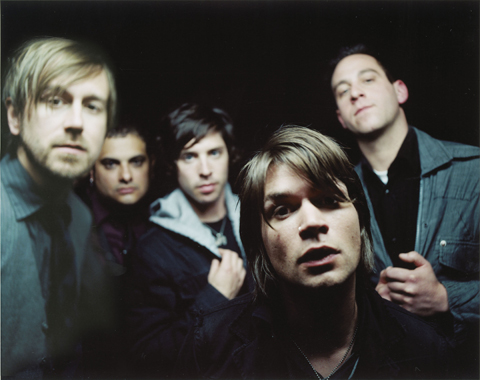
BREAK YOU DOWN SO BADLY Kids who wanted to know why Taking Back Sunday (above) allegedly hated Brand New could hit LiveJournal communities like "LI_SCENE" in the early 2000s. |
Remember the years before blog-rock, when scenes and sounds developed geographically? Although emo was one of the first musical movements inherently indebted to social networking sites (Myspace and LiveJournal were critical in propagating its introverted culture), it was also one of the last subcultures also to have on-the-ground brick-and-mortar infrastructure in specific towns. The emo epidemic grew out of post-hardcore DC in the '80s, ultimately spreading throughout the country, with the Midwest and Omaha getting hit particularly hard. Ultimately, though, "suburb" is synonymous with "troubled teen soul," so it's natural that Long Island and Jersey 'burbs became definitive emo capitals by the early aughts.WASHINGTON, DC | MID '80s | In DC's post-hardcore mid-'80s, the roots of emo were planted when Ian MacKaye of Minor Threat showed hardcore bros how to talk about their feelings. A period in 1984 and 1985 known as "Revolution Summer" did a lot to break the violence and hyper-masculinity that was then dominating hardcore. Rites of Spring formed in '84, setting a new tone: harsh hardcore became more melodic, with poignant, introspective lyricism. The style started getting pinned as "emo-core," though the band themselves detested the term. Rites of Spring were followed by Embrace in 1985 and a slew of others with a similar sound. Several influential artists in emo history, like Jawbreaker and Sunny Day Real Estate, cite the DC post-hardcore scene as their inspiration.
CHICAGO + MILWAUKEE | EARLY TO MID '90s | Before Brand New and Taking Back Sunday fans even knew what emo was, the Midwest experienced an emo explosion in the mid '90s, mostly around Chicago and Milwaukee. Cap'n Jazz, Braid, and the Promise Ring all came out of the region during this time, gaining national attention. Chicago's Jade Tree Records released seminal emo records by Lifetime, the Promise Ring, Cap'n Jazz, Jets to Brazil, Pedro the Lion, and, eventually, Alkaline Trio. Later, Fall Out Boy would form in Wilmette, Illinois, in 2001. Victory Records formed in Chicago in 1989, and over the years were responsible for key releases by Hawthorne Heights, Taking Back Sunday, Thursday, and others.
OMAHA, NEBRASKA | MID '90s TO MID '00s | Omaha label Saddle Creek surfaced in the mid-'90s — started in 1993 as a project for a college entrepreneurship class by Justin Oberst, the brother of Bright Eyes' Conor Oberst, and Mike Mogis, who would go on to become a star emo producer. The label maintained a twangy Nebraskan sound where emo, indie rock, and Americana intersected, but Conor's self-loathing poetry got the label its rep for being hyper-emo. Other notable Saddle Creek outfits were the Faint — one of the few emo bands to incorporate bits of goth and New Wave— as well as emo legends Cursive.
LONG ISLAND, NEW YORK | EARLY '00s | When emo reached the suburban teen market in the early '00s, America's original suburb, Long Island, was an appropriate epicenter — with Brand New, Taking Back Sunday, Straylight Run, Glassjaw, the Movelife, and dozens of others reaching international acclaim. The local community boomed until 2006, with local bands playing temples, VFWs, and a mid-size club in Farmingdale called the Downtown — the heart of LI's world-renowned Nassau County emo scene. LI emo kids spent a lot of time on LiveJournal communities like "LI_SCENE," planning meet-ups and spreading rumors about why Brand New and Taking Back Sunday hated each other.